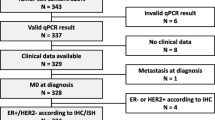Abstract
Background
Prognostic and treatment-predictive biomarkers in primary breast cancer are routinely analyzed in the primary tumor, whereas metastatic tumor cells in lymph node metastases are not characterized. The present study aimed to define the concordance between biomarkers in matched pairs of breast cancers and lymph node metastases and to relate their expression to clinical outcome.
Methods
Patients with primary breast cancer treated with adjuvant tamoxifen for 2 years were included. A tissue microarray of primary tumors and lymph node metastases was constructed, and estrogen receptor (ER), progesterone receptor (PR), human epidermal growth factor receptor 2 (HER2), and Ki67 were analyzed immunohistochemically in 262, 257, 104, and 101 patients, respectively. Five years’ distant disease-free survival (DDFS) was used as the primary end point.
Results
The concordance for biomarker expression in primary tumors and corresponding lymph node metastases was 93% for ER, 84% for PR, 97% for HER2, and 85% for Ki67. The discordant cases for HER2 status were all negative in the tumor but positive in the node. ER positivity was a significant independent predictor of improved 5-year DDFS when analyzed in the primary tumor as well as in the lymph node metastases. Ki67 positivity analyzed in both locations correlated with shortened DDFS. HER2 positivity at both locations was an indicator of early relapse.
Conclusions
The concordance for the biomarkers analyzed in matched pairs of primary tumors and lymph node metastases was high. Moreover, survival analyses showed that the expression of biomarkers in lymph node metastases can provide prognostic information when no analyses of the primary tumor can be done. Treatment selection based on biomarkers in the lymph node is a topic for further studies.




Similar content being viewed by others
References
Cinieri S, Orlando L, Fedele P et al (2007) Adjuvant strategies in breast cancer: new prospectives, questions and reflections at the end of 2007. St. Gallen international expert consensus conference. Ann Oncol 18(Suppl 6):vi63–vi65
Carter CL, Allen C, Henson DE (1989) Relation of tumor size, lymph node status, and survival in 24, 740 breast cancer cases. Cancer 63:181–187
Jatoi I, Hilsenbeck SG, Clark GM et al (1999) Significance of axillary lymph node metastasis in primary breast cancer. J Clin Oncol 17:2334–2340
Early Breast Cancer Trialists Group (1998) Tamoxifen for early breast cancer: an overview of the randomized trials. Lancet 351:1451–1467
Piccart-Gebhart MJ, Procter M, Leyland-Jones B et al (2005) Trastuzumab after adjuvant chemotherapy in HER2-positive breast cancer. N Engl J Med 353:1659–1672
Breast International Group (BIG) 1-98 Collaborative Group, Thurlimann B et al (2005) A comparison of letrozole and tamoxifen in postmenopausal women with early breast cancer. N Engl J Med 353:2747–2757
Hurvitz SA, Pietras RJ (2008) Rational management of endocrine resistance in breast cancer: a comprehensive review of estrogen receptor biology, treatment options, and future directions. Cancer 113:2385–2397
Klein CA (2009) Parallel progression of primary tumors and metastases. Nat Rev Cancer 9(4):302–312
De la Haba-Rodriguez JR, Ruiz Borrego M, Gómez España A et al (2004) Comparative study of the immunohistochemical phenotype in breast cancer and its lymph node metastatic location. Cancer Investig 22(2):219–224
Dikicioglu E, Barutca S, Meydan N et al (2005) Biological characteristics of breast cancer at the primary tumor and the involved lymph nodes. Int J Clin Pract 59(9):1039–1044
Cardoso F, Di Leo A, Larsimont D et al (2001) Evaluation of HER2, p53, bcl-2, topoisomerase II-alpha, heat-shock proteins 27 and 70 in primary breast cancer and metastatic ipsilateral axillary lymph nodes. Ann Oncol 42(7):615–620
Chebil G, Bendahl PO, Idvall I et al (2003) Comparison of immunohistochemical and biochemical assay of steroid receptors in primary breast cancer—clinical associations and reasons for discrepancies. Acta Oncol 42:719–725
Honeth G, Bendahl PO, Ringner M et al (2008) The CD44+/CD24− phenotype is enriched in basal-like breast tumors. Breast Cancer Res 10:R53
Ahlin C, Aaltonen K, Amini RM et al (2007) Ki67 and cyclin A as prognostic factors in early breast cancer. What are the optimal cut-off values? Histopathology 51:491–498
Becker TE, Ellsworth RE, Deyarmin B et al (2008) The genomic heritage of lymph node metastases: implications for clinical management of patients with breast cancer. Ann Surg Oncol 15:1056–1063
Weigelt B, Glas AM, Wessels LF et al (2003) Gene expression profiles of primary breast tumors maintained in distant metastases. Proc Natl Acad Sci U S A 100:15901–15905
Sorlie T, Perou CM, Tibshirani R et al (2001) Gene expression patterns of breast carcinomas distinguish tumor subclasses with clinical implications. Proc Natl Acad Sci U S A 98:10869–10874
Santinelli A, Pisa E, Stramazzotti E et al (2008) HER2 status discrepancy between primary lesions and metastatic sites. Impact on targeted therapy. Int J Cancer 122(5):999–1004
Ryden L, Haglund M, Bendahl PO et al (2009) Reproducibility of human epidermal growth factor receptor 2 analysis in primary breast cancer—a national survey performed at pathology departments in Sweden. Acta Oncol 48:860–866
Acknowledgments
We are indebted to the participating departments of the South Sweden Breast Cancer Group for providing us with breast cancer samples and clinical follow-up data; to Kristina Lövgren for skilled technical assistance with preparation of the tissue microarray, staining procedures, and examination of the slides; and to Janica Kallonen for examination of the slides. The study was supported by funds from the medical faculty and University Hospital Lund (ALF), The University Hospital of Lund Research Foundation, the Swedish Pink Ribbon Campaign, and Skåne County Council’s research and development Foundation.
Author information
Authors and Affiliations
Corresponding author
Rights and permissions
About this article
Cite this article
Falck, AK., Fernö, M., Bendahl, PO. et al. Does Analysis of Biomarkers in Tumor Cells in Lymph Node Metastases Give Additional Prognostic Information in Primary Breast Cancer?. World J Surg 34, 1434–1441 (2010). https://doi.org/10.1007/s00268-010-0499-z
Published:
Issue Date:
DOI: https://doi.org/10.1007/s00268-010-0499-z




